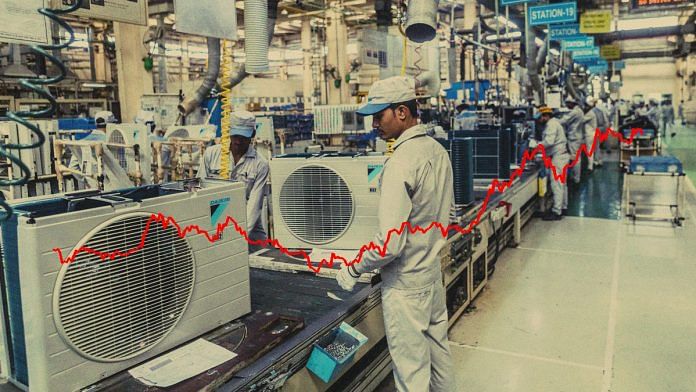The government has hiked import duty on 19 items, including washing machines, air conditioners, footwear, diamonds, jet fuel, as part of its plan to reduce the current account deficit (CAD) and arrest the fall of the rupee.
ThePrint asks- Duty on 19 items increased: Back to license-Raj era or essential to cut down import bill?
Govt response to falling rupee shows inability to diagnose disease
 Narendar Pani
Narendar Pani
Professor, National Institute of Advanced Studies
The government’s response to the depreciation of the rupee has mixed a touch of realism with an inability to diagnose the disease. Unlike what economists who have controlled the narrative since 1991 would have us believe, liberalisation has not delivered all that it promised. The vow of making India a globally competitive economy is still far from being realised. Exports in dollar terms in 2016-17 were in fact 12 per cent less than in 2013-14.
With expectations of export-led growth belied, liberalisation was largely reduced to global competition in the Indian market. This competition resulted in growth in trade, hotels, transport and communication, financing, insurance, real estate and business services. The share of these sectors in gross value added (GVA) went up from 43 per cent in 1990-91 to 57 per cent by 2011-12. But with the other sectors under pressure, the number of customers to whom such services could be provided has tapered off. This has led investors, both Indian and foreign, to seek greener pastures elsewhere in the world, thereby increasing the pressure on the rupee.
The knee-jerk reaction of raising tariff barriers will only make things worse. It will directly raise the prices of imported goods, thereby reducing the pressure on Indian producers to keep their prices down. Higher domestic prices will increase the real effective exchange rate and encourage an even further devaluation of the rupee.
The way out of the current crisis is to reduce costs in India, even if that means well-designed subsidies. Oops! That word has been unmentionable since 1991.
Increase in import duties a welcome step, will benefit our industry
 Ajay Sahai
Ajay Sahai
Director general and CEO, Federation of Indian Export Organisations
The decision to increase import duties is, by and large, a welcome step. Mostly these are consumer goods, though a few are components and parts. This will benefit the industry in a big way, though I personally feel that this is a temporary measure. A huge rise in the imports of electronic goods was becoming a cause for concern.
Imports of electronic goods increased from $40 billion in 2016-17 to $50 billion in 2017-18. So, while higher oil prices have primarily contributed to the ballooning of the import bill, the inward shipment of non-essential items has also played a part.
The constant increase in trade deficit figures of items other than oil and gold was indeed an area that needed immediate attention. Global oil prices will fluctuate and we can do little about it, but we need to ensure that trade deficit otherwise remains under control.
The increase in tariff and the depreciating rupee will provide double protection to the domestic industry and will also enable it to compete with imports. However, it is critical for the domestic manufacturers to put their act together meanwhile and boost production so that the dependence on imports is reduced. We will see sustained results in keeping trade deficit and current account deficit under control — only if this is done.
A window has been provided and this must be seized by our manufacturers.
Hope it’s a temporary measure & will be reversed once difficulties are over
 Bidisha Ganguly
Bidisha Ganguly
Chief Economist, Confederation of Indian Industry
An increase in customs duty on 19 items was announced Wednesday as a measure to curb the rising current account deficit (CAD). The items referred to as ‘non-essential’ have been chosen carefully from among consumer items such as white goods, plastics and jewellery – a combination of finished goods and intermediates. A cursory look at the numbers indicates that the impact on the CAD is likely to be limited. The import of these items amounted to Rs 86,000 crore or about $12 billion in FY18. This is a relatively minor 2.6 per cent of our total import bill.
Nevertheless, it is fortunate that the government has contained its move to a limited set of items. A bigger move would have had a disruptive impact on both consumers and businesses. Consumers whose disposable incomes are already affected by the rising oil prices will have to shell out more ahead of the festive season and this could force them to cut down their purchases.
For businesses, a downturn in consumer demand does not bode well. Firms that have made investments based on the existing duty structure for imported intermediates and a positive outlook on consumer demand will see their margins getting squeezed.
One hopes that this is a temporary measure and will be reversed once the difficulties are over. Meanwhile, other measures may be taken to increase capital inflows to fund the deficit. Payment in rupees for oil from Iran and Russia will also cut down on dollar outflow. In the medium term, there is no option but to make exports more competitive.
Also read: India may raise duties on aluminium imports as US-China trade war sparks dumping fear
It is now cheaper to import finished products than to manufacture in India
 Mahua Venkatesh
Mahua Venkatesh
Associate Editor, ThePrint
Raising import duties to curb imports and maintain the current account deficit – the difference between the inflow and outflow of foreign currencies – is myopic. It is true that imports of non-oil and non-gold items have increased in the last few months but raising import duties will perhaps help the country’s policymakers only psychologically. This will naturally come as a dampener for Indians who typically increase their spending before the festive season.
Let’s understand this—about 70 per cent of India’s oil requirements are imported and the depreciation of the rupee on one hand and escalation of global crude oil prices on the other have pushed our import bill. So, cutting down on imports of non-oil, non-gold items will have limited impact.
It is common knowledge that our duty structure is lopsided and this is encouraging imports. It needs to be corrected to boost manufacturers within the country. Today, it is cheaper to import finished products than to manufacture here and sell.
At the same time, despite the depreciation of the rupee, the country’s exporters are struggling due to several reasons including the shortage of credit. Also, currencies of most other emerging economies have depreciated too, so Indian exporters are not getting any advantage.
The prescription for the widening CAD is to immediately look into the problems of exporters and resolve them so that they can take advantage of the global situation and the currency depreciation. Exports need to exponentially grow and that will take care of most problems.
By Fatima Khan and Mahua Venkatesh.



